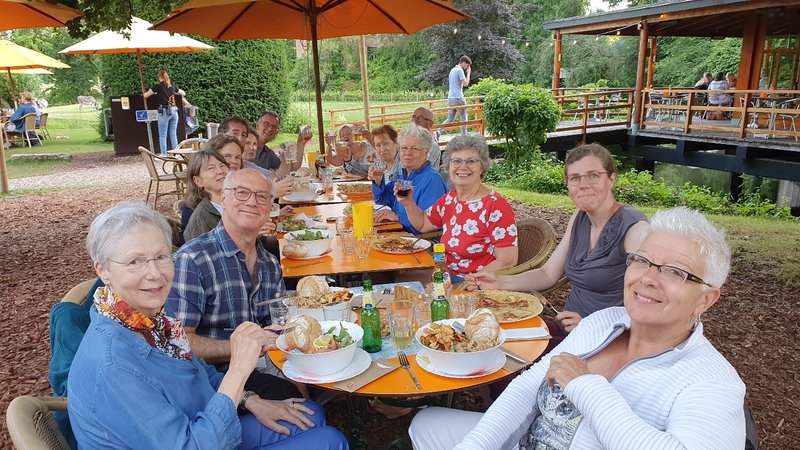
Jenny writes about the Utrecht SIG Social that took place on Wednesday 13 July 2022.
This month, Utrecht SIG met in person for the first time in a year. We followed the same successful formula of our previous social gathering, which we had decided was definitely voor herhaling vatbaar.
We met in the car park at Theehuis Rhijnauwen, where we chatted more than we swapped books. I already have a large pile of books waiting to be read, and had vowed to myself not to take any books home. But how could I resist when one of the books I’d recently put on my ‘to read list’ was smiling at me from the boot of a car?
Tony Parr, who recently announced his impending retirement, had a great selection of business books. I didn’t want any duplicates, but I did find one or two gems among his collection. I think I came away with five fiction and three reference books, so I’ve plenty to read during the long hot summer we’re expecting!
When it was clear no more books were going to swap owners, we ambled to the restaurant. We waited a few minutes while the staff prepared a banqueting table where we could all sit together.

The pancakes were delicious, as was the strawberries and ice cream dessert, which was definitely a sharing portion. Next time, I think I’ll choose a maaltijd salade, they looked delicious and were enormous.
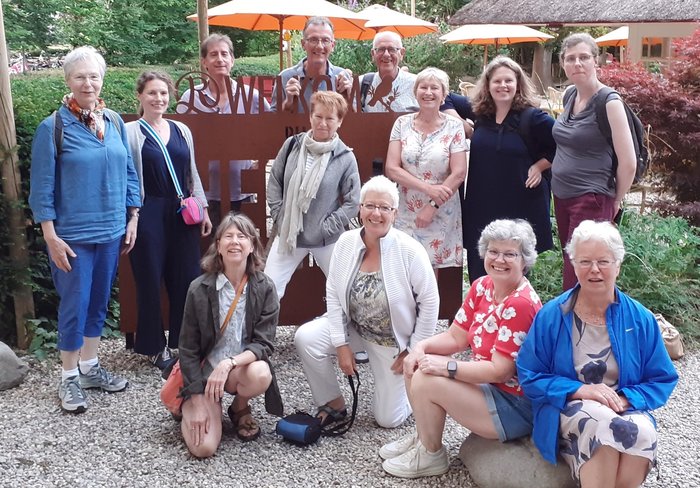
Double the attendance compared to last year and once again, a member from Zwolle had travelled the furthest.

After all that sitting and eating, it was time to get moving again. Walking and talking – another great networking opportunity.

Curtis Barrett guided us on a leisurely stroll around the park where we found some people messing about on the river and this bunch of twigs taking a walk too.
Do come and join us at the next Utrecht SIG business meeting on 14 September and for our social gathering next year. Keep an eye on the SENSE Events calendar for more details.
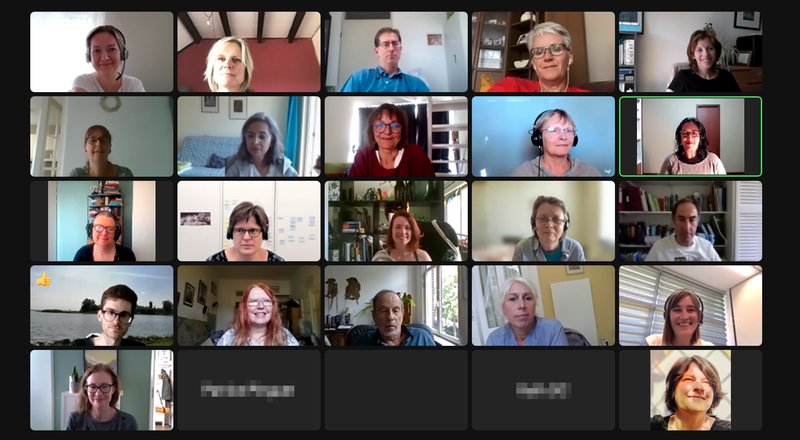
Nandini Bedi shares with us her experience of the Marketing Mindset workshop held on 6 July 2022.
As a part of the SENSE CPD online events, Dr Malini Devadas – scientific editor and mindset coach – was invited to address members about a marketing approach for freelance editors. The session took the form of a short presentation of about 10-15 minutes, after which 45 minutes were devoted to a Q and A. As can be imagined, not only was it was well attended, but there was also a lot to discuss! In her short presentation, Malini focused on how to define the problem, a three-step approach to finding ideal clients and developing the confidence to grow one’s business without complicating life for oneself by giving in to thoughts that get in the way. The slides were shared with those who attended.
Marketing strategies already in use by SENSE members
Some of these are: a website as a means to communicating credibility and legitimacy, posts on LinkedIn and an email newsletter; directly approaching existing clients to inform/check/communicate – or in other words to let them know where you stand in terms of your availability and to remind them that you are there should they need an editor; and lastly, the importance of word of mouth.
Concerns
There were also concerns that came up. Is it possible in this day and age to market oneself if one is not into social media? While Malini herself is very active on social media (check her out on Facebook and Instagram), she does not propagate it as the best or only way. Her approach is to put plenty of content out there in the world, with the idea of reaching out to those who are not yet convinced of their need for an editor. It’s her way of making contact with this particular group, so that they, over time, get to see the value an editor would add to their writing, as well as why paying for this service is worth it. If one is not into social media, then the email newsletter referred to in the previous paragraph, or a request to satisfied clients to pass the message on to colleagues would work just as well. However, as a member pointed out, word of mouth works if one keeps doing the same thing, but in order to introduce a new service, social media would be more effective.
How does one present oneself if there’s more than one service on offer, especially if these are quite different to each other? In other words, how does one target different groups? Malini suggested segregating one’s services over different platforms, and/or clearly defining these as two separate entities on one’s website, (check out hers at mdwritingediting.com.au). And this leads to another question that came up about whether it is more effective to use one’s name or a company name – to which her reply was that she thinks most people who choose her do so because they remember her and her work and not the name of her company. Her homepage is worth looking at to get an idea of her approach.
How does one get one’s foot in the door of an institution? Ever thought of offering a free speech in which you present what you do? This is not that different to putting out content about what you do via social media and is therefore a useful strategy for those who aren’t into social media.
The message to take home
To my mind, a very important message that Malini had to give was not to overthink and procrastinate, but to get out there and reach out to as many people as possible with what’s on offer, in the way that suits one best. Start and be aware of what works and what doesn’t. Change strategies if necessary. Use trial and error to go forward. To her mind, just sticking it out over a period of brings rewards. Too many of us give up and that’s the pity. Persistence pays. In the end the ones who don’t give up reap the benefits over time and develop a marketing mindset.
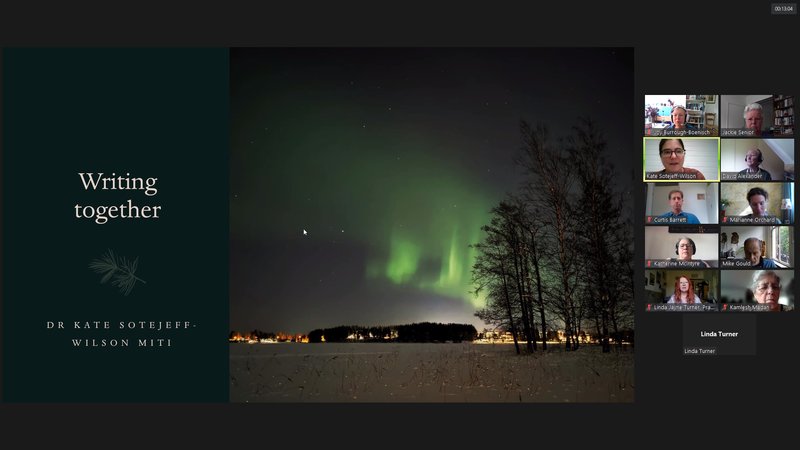
UniSIG report: Kate Sotejeff-Wilson on social writing: ‘Call it a meeting’
At the UniSIG meeting on 1 July 2022, Kate Sotejeff-Wilson talked about her experience of social writing with academics. Kate is a translator and editor, and she also facilitates writing retreats.
Social writing, Kate explained, is when a group of people get together, either online or offline, to write. The writers set goals together, the facilitator tells the group when to start writing and everyone works on their own project until the facilitator tells them to stop. The group then discusses how the writing went.
Kate mentioned a few things social writing is not: a workshop, in that you don’t critique one another’s writing; a boot camp, in that support is more important than productivity; teaching, in that the facilitator is a peer; and a competition, in that the writers are companions rather than competitors.
Who might benefit from social writing? Anyone, said Kate. Academics come to her retreats but so too do creative writers, and they inspire one another. ‘Someone who’s not involved in your work can see things you can’t see yourself.’ Translators could also try social writing, she added, because it gives you the chance to find your own voice and separate your voice from the author’s.
‘Can the writers be writing in different languages?’ Joy Burrough-Boenisch asked.
‘Yes,’ said Kate. Her social writing retreats are in Finnish and English. ‘I’m like a flight attendant: I stand there and say, “Let’s start writing,” in both languages.’
Why might people want to try social writing? Time, space and community, said Kate. Social writing gives you time to focus and the space to create. And as a community you share a commitment to write. You’re away from distractions such as your phone, social media and email. You set a goal – Kate gave the example of 500 words – and share how it went afterwards. ‘You’ll be amazed how much you get done.’
Kate gave three examples of how to go about social writing: informal writing with colleagues, through a professional organization (eg, MET’s Humanities and Social Science special interest group) and structured social writing (eg, a retreat).
Then it was time to discuss the ideal location for social writing, whether online or in person is better and whether social writing would work in the Netherlands. Would people be willing to travel? Would they do as the facilitator says? Would they be willing to pay? Would it be a good idea to limit numbers?
Start small, was Kate’s advice, and find out what works. Start meeting online or in a café and move on to booking a venue if people are interested. For academics, one of the draws of social writing is being able to devote time to writing, away from other responsibilities like teaching and supervision. ‘Schedule social writing,’ said Kate. ‘Call it a meeting!’
About Kate-Sotejeff-Wilson
Dr Kate Sotejeff-Wilson translates from Finnish, German and Polish into English at KSW Translations. She also edits in English for academic and multilingual writers. She facilitates writing retreats online and in person at Ridge Writing Retreats. She was born in Wales and did her history PhD research in London, Berlin, Poznań and Warsaw. Now she is also a Finn and has lived in Finland since 2012. She is chair of Nordic Editors and Translators.

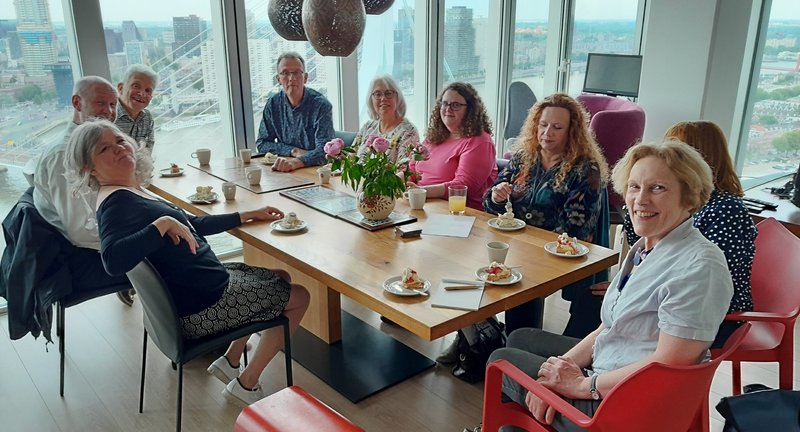
Suzanne Rietveld writes:
On 26 March 2022, I attended the online AGM to see what was happening at SENSE and to meet some of my colleagues. Someone mentioned that the new members seemed less active than expected. This was the moment that I wanted to contribute to the discussion. I explained that this reduced activity should be reviewed within the context of the Covid situation. I told the other members that I registered with SENSE in January 2020 and was eager to see what kind of people I would meet, and what options there would be to learn and interact with mindlike colleagues. All this was disturbed by several lockdowns and restrictions. So, the new members were not less active by choice but by the circumstances of the last two years.
I wanted to put my money where my mouth was and volunteered to host the Zuid Holland SIG on 31 May 2022, advertising the event with the great views from my apartment in De Rotterdam! The event needed a theme, so I decided to give the attendees some tips and tricks on subtitling. That was quite scary, I must confess. Providing the view and the catering was something I was used to, but preparing a talk about subtitling was a challenge because I am not used to speaking in public and I was not 100% sure that I was the right person to share my knowledge.
So, after the invitation was posted online and the first attendees started to sign up, I started to prepare my presentation. I assumed that most of the colleagues would not be experienced with subtitling, other than an odd job in Word, and that some of them would be familiar with the discussion about the specialized skills involved. I wanted to explain more about the technical side of the profession and started my presentation by explaining that my training consisted of a 10-week course of 2 hours per week at ITV Utrecht. So not something I could share within half an hour.
The main issue with subtitling is the fact that reading a sentence takes longer than listening to a sentence, leading to restrictions in reading speed and the number of characters per second. This, combined with a limit in characters per line, often leads to the need to compact the title's content without losing the conveyed message. I use Subtitle Edit myself and showed its settings such as characters per second (around 14–16) and the title's length (between 1 and 8 seconds and with a maximum of 40 characters per line).
I also explained that I prefer to 'spot' the titles by eye instead of by ear. I use the waveform that comes with every MP4 file to do so. The waveform is a graph that shows the speaker's volume and therefore is very useful to mark the start and end of a spoken sentence. Depending on the length and structure of the sentence, you decide how many titles you will need for this particular sentence.
We discussed the ways to shorten the titles, such as leaving out repetitions, stop words, adjectives, adverbials, quantifiers and introductory phrases. The conclusion was that we should only compact the title if this is really necessary. In the end, the afternoon went very well. We all fitted around my table (11 people) and enjoyed the cakes from the local bakery. We got to know each other better, and everyone seemed happy with the shared information.
The overall message was that a subtitle has to convey the right message, and the reader should be able to finish reading the title before it disappears off-screen. Yes, subtitling involves special skills, but don't be afraid to give it a go if a task comes up and offers some flexibility on time spent, and in the worst case, to ask a friend. I proofread and subtitle in English and Dutch 😊
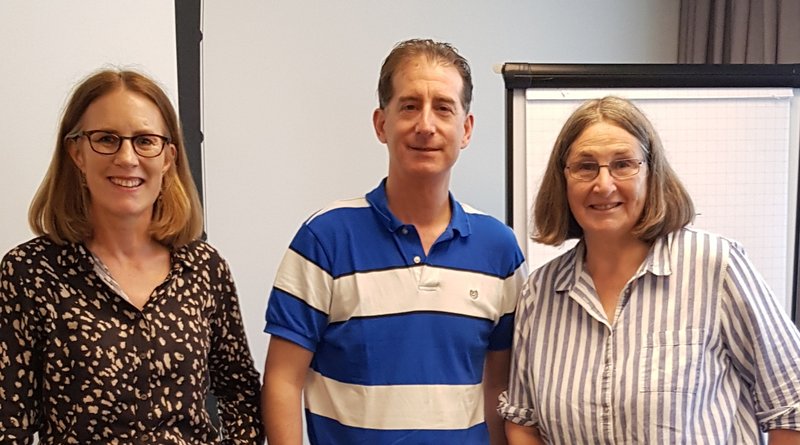
All together again: a summary of the SENSEMed workshop in Utrecht
On 11 June, after 27 long months of Zooming, SENSEMed members finally met in person in Utrecht for a one-day workshop on working with medical texts. Daphne Visser-Lees kicked off with a lively session on translating medical texts from Dutch into English. She explained which texts might need expert medical knowledge to translate (such as case reports and articles) and which ones probably don’t (leaflets for patients, medical insurance documents). She then led us through two translation exercises. The first highlighted common terminology issues we might face when translating medical texts from Dutch into English – for example, Hernia typically refers to a herniated or slipped disc in Dutch whereas it generally means an abdominal hernia in English. The second explained how to decipher and translate case notes from a Dutch GP (not always – or never – easy!). Daphne’s extensive medical experience serves her well when tackling these difficult jobs and we were all grateful for the opportunity to learn from her knowledge and expertise.
Sally Hill and Curtis Barrett were up next with their editing slam. Sally and Curtis had both edited an abstract from a medical research article and presented and explained their changes sentence by sentence. This was an engaging session with plenty of questions and input from the audience. Sally and Curtis had both improved the clarity and readability of the text with their changes – but they did not always agree on what changes were best. This session highlighted just how subjective editing can be and that there is never one right solution to a difficult sentence. It also highlighted how we need to be aware of changes in scientific style and keep in mind that our own preferences (such as whether to use the Oxford comma or italicize Latin words) may not align with the style guide our client has to follow. Sally and Curtis finished up by giving a useful summary of what they do before starting an editing project and before delivering an edited file, both of which involve careful and specific communication with the client. A very enlightening session overall.
After a tea break, Sally was up again to talk to us about medical writing. Sally moved from freelance to in-house work last year after accepting a job as a senior scientific writer for the biotech company Merus. The goal of her talk was clear: to make us aware that medical writing exists. Job done. She explained what kind of texts medical writers are typically asked to produce (broadly divided into regulatory writing and medical communications) and what skills a medical writer should have (writing skills, scientific expertise, document expertise, and project management skills). To highlight how important (and complicated!) project management can be for a medical writer, Sally led us through a short exercise where we had to list the things we would need to consider before developing a timeline for a proposed writing project. The session was informative and inspiring, and Sally may well have succeeded in recruiting some future medical editors into her fold.
The participants were all grateful to Curtis, Daphne and Sally for taking the time and trouble to organize such a great workshop. We were all delighted to see each other in person again and are looking forward to many more such events in the future!
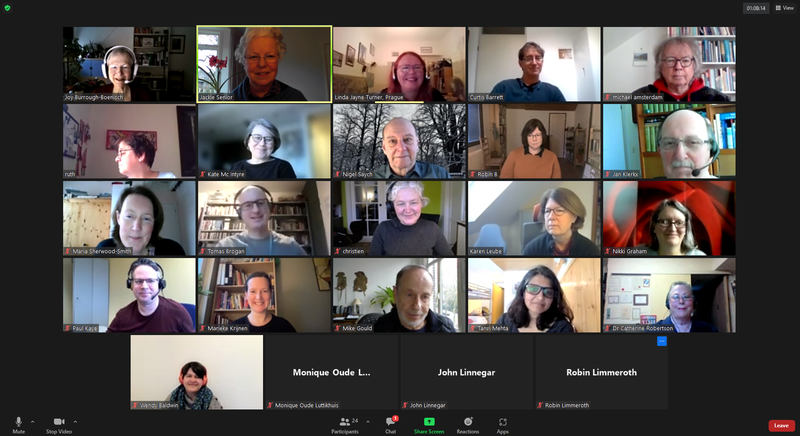
At the 18 February UniSIG meeting, SENSE member Linda Jayne Turner talked about her experience working for clients in academia in Germany and the Czech Republic. A teaching job at Charles University brought Linda to Prague in 2004, and while she has remained there, she also has many clients in Germany, where she lived previously. She mostly edits journal articles written by academics to be submitted to journals (mainly in the social sciences); she also edits colleagues’ English translations from German and Czech.
In her talk, Linda touched on some of the differences between working for clients in the two countries. In general, she thinks her Czech clients are more diffident about their prowess in English and more relaxed about deadlines. Her German academic clients pay higher rates and expect to be invoiced per hour’s work (that’s generally equivalent to editing about 1000 words), whereas in the Czech Republic she is expected to charge per page (assuming 1800 characters per page), but can also charge an hourly rate in some cases. Her German clients often have to request bids from three language professionals, but don’t always go for the cheapest, preferring instead to give the assignment to Linda, whose work they trust and appreciate. Invoices issued to German universities should ideally be paid into German banks to avoid additional paperwork, so Linda has kept her bank account in Germany.
It seems that the bugbear in both countries is Kafkaesque bureaucracy. Although Kafka’s depiction of the Czech establishment arises from his own experience of the system in Prague imposed in the days of the Austro-Hungarian Empire, Linda thinks present-day German bureaucracy is even more convoluted.
Linda makes a point of visiting Germany several times a year, under normal circumstances, and when she does, she contacts her clients in advance to invite them to meet up with her. These informal meetings are usually at the end of the working day and take place in a café, restaurant or bar. Chatting over coffee, a meal or a drink is a good way to get to know more about clients and to get useful feedback from them. It also makes it easier to deal with any subsequent issues that might arise while working together.
At this lively UniSIG meeting there was plenty of input from the 24 attendees. It was pointed out that in Germany and the Netherlands, agencies corner editing and translation work through aggressive marketing, and the texts they supply to their university clients are sometimes in poor English. Linda’s mention of her arrangements for receiving payment from German clients sparked recommendations for companies to use for receiving payments from non-euro clients: PayPal, Wise (formerly TransferWise) and Stripe (cheaper than Paypal).
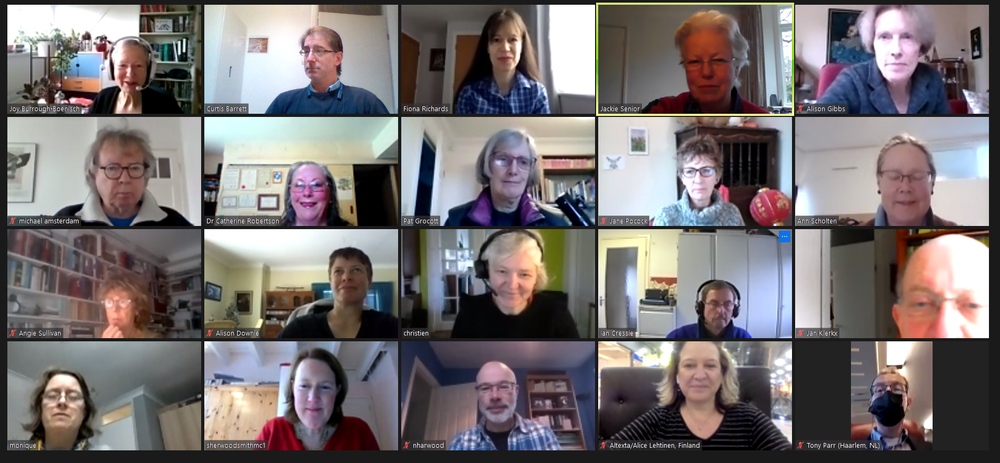
UniSIG’s last meeting of 2021 (10 December) was a presentation by Fiona Richards, a 3rd-year PhD student at Sheffield University (UK). Whatever the many downsides of the pandemic, one of the benefits is the increasing geographical spread of SENSE members able to attend our presentations on Zoom. On this occasion, for example, members from the Netherlands were joined by members from countries as far afield as South Africa and Finland.
Fiona’s field of study is Teaching English to Speakers of Other Languages. Her research, supervised by Nigel Harwood (speaker at a previous UniSIG meeting), involves investigating proofreading practices at a UK university from the perspectives of L2 (English as a second language) students, proofreaders and lecturers. The aim is to determine the extent to which proofreaders can help students improve their English writing, while simultaneously adhering to proofreading guidelines intended to uphold academic integrity. As Fiona explained, her interest in proofreading practices at a tertiary level stems from her background in teaching pre-sessional courses in which she has seen the challenges faced by L2 students producing written work for assessment.
During her presentation Fiona discussed the preliminary findings from the interviews she held with a student writer (high IELTS score), the student’s proofreader, a senior lecturer and a retired senior lecturer, followed by a brief discussion of the implications of her data and their bearing on university proofreading guidelines.
Her focus was on how they viewed the ethical appropriateness of the following types of proofreading interventions made to the student’s thesis:
- additions (1-5 words);
- deletions;
- substitutions (one word for another);
- reordering (word order);
- structural editing (eg, moving paragraphs);
- rewriting (advising changes to meaning and content);
- mechanical alterations (eg, adding italics, punctuation, applying conventions).
The post-presentation discussions covered issues familiar to many SENSE members, including:
- The continuing confusion between proofreading and copy editing;
- Differences between writing acceptable for assessment and writing acceptable for publication;
- ‘Mixed messages’ from lecturers who sometimes seem hostile to students genuinely wanting to improve their English by having their work revised by a language-editor/coach. In this respect, the guidelines for students are sometimes unclear;
- Affordability of editing: although universities may provide writing advice services, students are not always aware of them, and not being able to afford a professional editor can put students at a disadvantage;
- Whether proofreaders should explain their proposed changes (by inserting a comment, for example) or just make the change;
- Dangers of overzealous proofreading (‘doctoring the evidence’ or ‘silencing the author’s voice’).
Fiona hopes to complete her PhD in the coming year and in future to investigate a wider range of student work, including work by students with lower levels of English as a foreign language. We wish her all the best.

As a professional wordsmith, you of course know what shortcuts are. You are probably using some in your daily work, like CTRL+S to save your work or CTRL+Z to undo whatever you shouldn’t have done. Chances are that you have considered the many more out there that you should be using.
Indeed, you really want to use keyboard shortcuts as much as possible, because they help you work more quickly, make your work easier and they reduce the risk of RSI from swinging that mouse around. No wonder most software programs include many handy shortcuts – Microsoft Word alone includes over 200 of them. But memorizing hundreds of shortcuts is quite a daunting task, so how do you know which ones are really worth remembering?
Luckily, Linda Comyns was so kind as to explain which Word shortcuts she finds most useful as a translator, an editor and a teacher. Attendees of this online SENSE event were encouraged to try out the different shortcuts in their own files and they were exuberant about their new editing superpowers. Below are my personal favourites:
I was delighted by the discovery that I can move to the next word to the left or to the right of the cursor or move up or down a paragraph using CTRL+arrow keys. That is decidedly easier than moving one character or one line at a time without the CTRL key. Similarly, Shift+CTRL+arrow keys will select words or paragraphs in the desired direction. When I try to select bits of texts with my mouse, I usually ended up selecting more or fewer words than I intended. Using Shift+CTRL+arrow keys to select the text before cutting (CTRL+X) and pasting (CTRL+V) it are real timesavers for me.
If you need to do a lot of formatting in Word, you will find CTRL+B, CTRL+I and CTRL+U very helpful to put words in bold, italics or to underline them. Removing all the manual formatting could not be easier than hitting CTRL+Spacebar. Do you need a heading? ALT+CTRL+1/2/3 will apply heading style 1, 2 or 3 in no time.
Naturally, you can do all these things with your mouse, but once you get the hang of it, using the mouse suddenly feels very cumbersome indeed. Although a few shortcuts are fairly universal, not all of these will work across Office applications or on other operating systems. Mac users can try the Command or Alt key, press Shift+Command or look up the Mac-specific keyboard shortcuts they need.
I was not the only attendee who learnt something new that day; many members and non-members got excited about these new ways of working. Some members even spontaneously shared their own favourite productivity tips.
Of course, we could not possibly round off a Southern SIG meeting without appointing the southern-most attendee as Southern SIG Member of the Month. This highly coveted honour was bestowed on Nina Woodson this time, who joined us from Los Angeles, USA – congratulations, Nina!
“How I had learned to communicate was different than the style used where I now was”
In her two-part panel discussion during the first SENSE Professional Development Day, Nandini Bedi made us aware of our communication styles. Her presentation revealed how style is a fundamental part of cross-cultural discourse. The styles we use and encounter as linguists are diverse, and we need to keep that in mind as we dialog and write.
When speakers use inductive communication, listeners are responsible for discerning the message. They must pick up on hints and patterns as the speaker gradually reveals their main idea. Nandini took her example from English textbooks, which position target structures within a text. After making sure students have understood the general idea, the structure is highlighted so students will notice it. Lastly, how the grammar works is finally explained. The textbook moved from general to specific, indirect toward direct.
In contrast, speakers who use deductive communication state their core message up-front, only filling in details and context as the narrative goes on. Deductive communication is the standard for academic articles written in Western scientific tradition. An introduction or abstract gives readers the main idea, and more details and context are eventually provided in the text body. Deductive communication makes the speaker responsible for comprehension. They must pre-empt any questions recipients might have.
Nandini emphasized that each communication style is nothing more than that: a style. Every style has advantages and pitfalls, and any style can leave their audience lost, especially if speakers don't share the same one. For example, inductive communication might seem evasive to deductive communicators, and deductive communication could feel rude to inductive communicators.
Our preferences for a given style reflect the communication patterns we acquired at home, at school, and at work. In other words, our cultural backgrounds are good predictors for the way we interact in the world. High-context cultures such as India encourage detailed context-giving. Nandini explained that explicit politeness strategies (which often adds to the length of interactions) are key to navigating highly stratified societies. Deductive communication has more social currency in low-context cultures such as Dutch culture. The Netherlands are more socially homogenous than India, Nandini pointed out.
Like languages, we can either acquire or learn our communication styles. The key to success is knowing your purpose and your audience. Nandini emphasized that when we speak, we must put ourselves in our interlocutor’s shoes. We need to think about how they will receive our message, and the method we choose should correspond to how well our idea will be received.
Nandini’s presentation was a wonderful reminder to be mindful of others' expectations for interaction. Following the formal presentation, attendees shared personal accounts of cross-cultural miscommunication. The crux of each example was invariably rooted in cultural assumptions. As professional communicators, we inhabit the spaces between our clients and their audiences. It is our responsibility to mind the gap and leave a footprint that anyone on the other side will recognize.
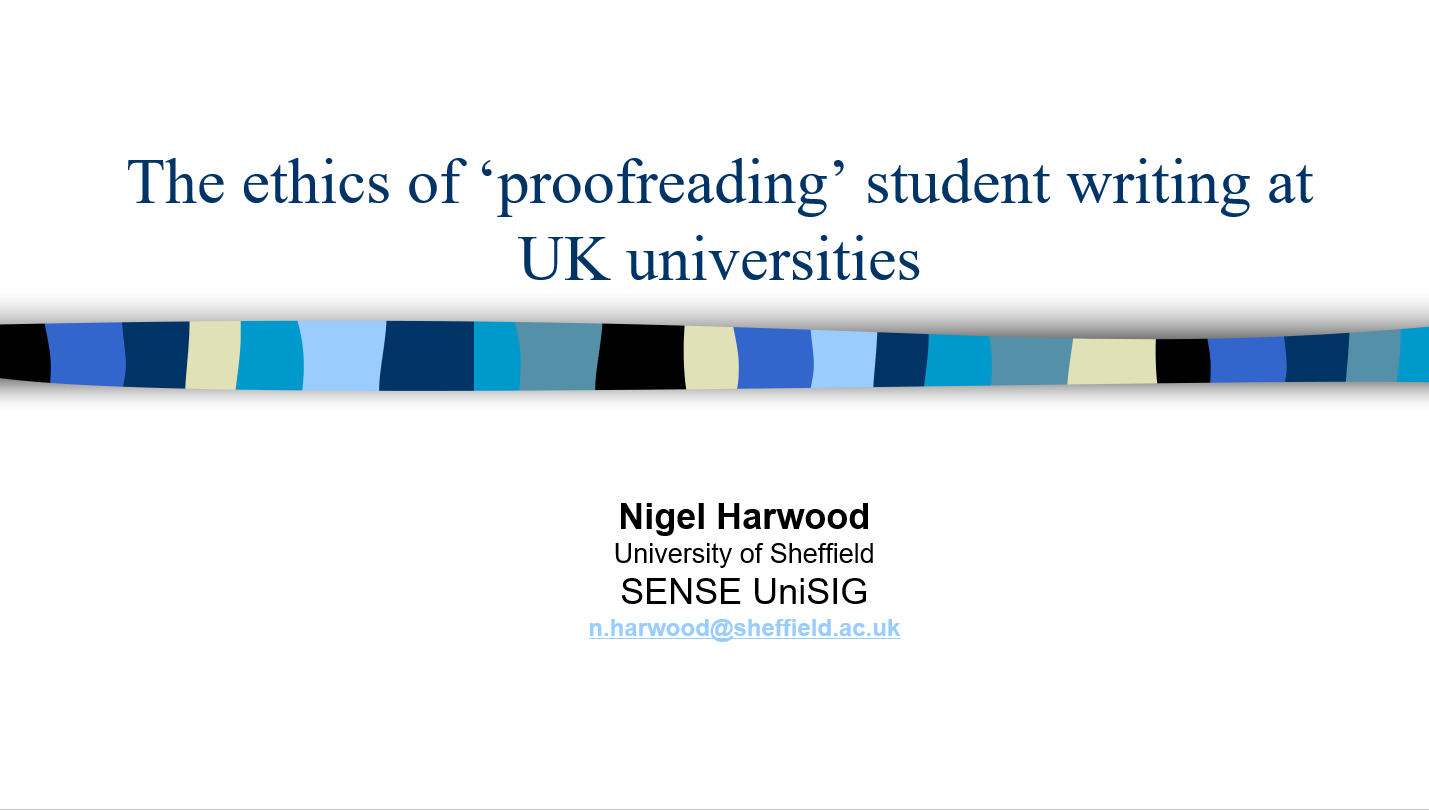
Nigel Harwood, now Professor in Applied Linguistics at Sheffield University, is no stranger to SENSE. In 2014, when we were developing SENSE’s Guidelines for Proofreading of Student Texts, he and Liz Austen came to talk to SENSE about their research on proofreading practices at Essex University and that university’s policy and guidance on proofreading. At the SENSE conference in 2018 he presented his findings on proofreaders’ interventions in a Master’s text, and now he gave us an online presentation on The ethics of ‘proofreading’ at UK universities and reported on his recent study into students’, lecturers’ and writing tutors’ attitudes to proofreading practices.
Nigel explained the outcome of his recent research, which was driven by three questions:
- How far do university content lecturers, English language tutors and students feel it is ethically appropriate for proofreaders to intervene in students’ writing?
- Why do lecturers, tutors and students feel the way they do about the ethics of the various proofreading interventions?
The term 'proofreading' was used to cover a range of interventions including minor/major copy editing, structural editing, content editing, indirect editing, and no intervention. SENSE members raised queries about the definition and Nigel clarified that his terminology was based on his own work and that of Brian Mossop (York University, Ontario). Nigel’s definition – quoted in SENSE’s Guidelines – confines proofreading to student-authored texts by stating that it concerns making changes to ‘assessed work in progress’. After reminding us of this careful wording, he noted that it doesn’t apply to the practice in the Netherlands and elsewhere in mainland Europe of helping PhD candidates achieve publishable articles for their thesis.
Nigel’s study involved lecturers, EAP tutors and students (122 in total). The vast majority in all three groups were in favour of some form of proofreading. Unsurprisingly, students took a more permissive stance, with most approving of proofreading intervention. Lecturers and tutors took a less liberal view and voiced concerns about how proofreading interventions might affect student grading. Nigel explained that some lecturers believed that proofreading interventions should not be allowed where language usage and accuracy was being explicitly graded. Conversely, if the language was not part of the assessment criteria, why would the student need proofreading intervention? If the message and ideas were communicated adequately, especially in the case of multilingual authors, then the lecturers were satisfied: language accuracy was not an issue.
To put the results into perspective, Nigel elucidated the findings from the two extreme outliers among the lecturers. The ‘ultra-permissive’ lecturer believed that accessing proofreading intervention was completely acceptable and played a role in inclusivity. Nigel explained that while some students may have access to university-educated parents and well-educated networks they can turn to for proofreading and feedback, access to support via proofreaders and academic editors was a form of equality for those less fortunate. The extreme opposite – the ultra-non-permissive lecturer – believed that no intervention should be allowed, with an inference of cheating. Nigel contextualised this viewpoint by saying the assignments set by the non-permissive lecturer included assessment criteria for language accuracy. Summing up, Nigel pointed out that there was less agreement among the interviewees on how far proofreaders should be permitted to go. His three recommendations on how universities might safely authorise proofreading were to ‘permit only a lighter-touch version of proofreading which eschews content interventions; regulate proofreading by taking it in-house; and allow departments to permit or prohibit proofreading from assignment to assignment, depending on assessors’ aims, outcomes, and assessment criteria.’
One recurrent theme from the research was that ‘proofreaders’ (as defined in Nigel’s research) should not be commenting on or adjusting content. He did concede that some lecturers accepted comments and questions from the proofreader to prompt the author to consider faulty argumentation or missing information. This type of intervention is referred to as ‘editing for educational purposes’ by some universities.
In wrapping up his presentation, Nigel remarked there was still no consensus on how much intervention is acceptable. Some UK universities ban proofreading altogether, whilst others take a non-committal stance. Sheffield University, for example, has placed a blanket ban on proofreading but all students (English native speakers and international) are entitled to six hours of advice from the English Language Teaching Centre. One solution suggested by Nigel was to have ‘in-house’ staff to support academic writers through the university writing centres. However, this would not satisfy university staff who believed any intervention to be unethical and could lead to a return to unseen assessments.
Nigel’s presentation was enlightening and provided a clear message about the perspective of UK universities. We are grateful for Nigel’s time and look forward to hearing from him in the future about other EAP research interests.
